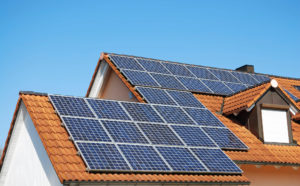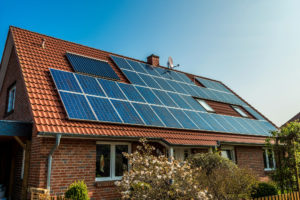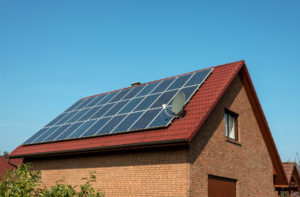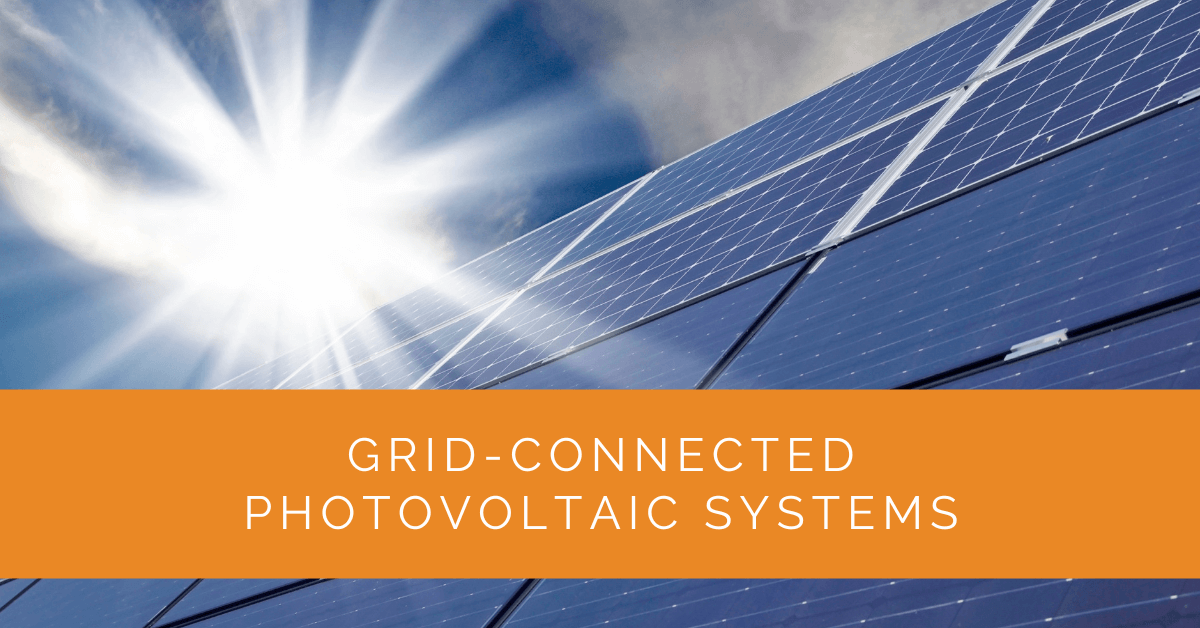The world’s increasing demand for renewable energy has brought grid-connected photovoltaic (PV) systems into the spotlight. These systems are an essential part of the transition towards a sustainable future. This article will delve deep into grid-connected PV systems, exploring their benefits, components, operation, installation, maintenance, and safety measures.
Contents
- 1 Key Takeaways
- 2 Benefits of Grid-Connected PV Systems
- 3 Components of a Grid-Connected PV System
- 4 How Grid-Connected PV Systems Work
- 5 Grid-Tied Solar Savings Calculator
- 6 Advantages and Disadvantages of Being Grid-Connected
- 7 Installing a Grid-Connected PV System
- 8 Maintenance and Monitoring
- 9 Grid-Connected PV System Safety
- 10 Case Study: Grid-Connected Photovoltaic System for a Residential Home
- 11 Case Study: Implementing a Grid-Connected Photovoltaic System for a Commercial Building
- 12 Expert Insights From Our Solar Panel Installers About Grid-Connected Photovoltaic Systems
- 13 Experience Solar Excellence with Us!
- 14 Conclusion
- 15 FAQ
Key Takeaways
- Grid-connected PV systems offer significant benefits, including reduced energy bills, environmental friendliness, and the ability to sell excess power back to the grid through net metering.
- Understanding the components and operation of these systems is crucial, with solar panels, inverters, and monitoring systems playing key roles.
- While they offer numerous advantages, grid-connected PV systems have challenges, such as grid compatibility and voltage fluctuations, which require proper planning and solutions for safe and efficient operation.
Benefits of Grid-Connected PV Systems
Grid-connected PV systems offer numerous benefits, making them a compelling choice for homeowners and businesses looking to harness the sun’s power.
Reduced Energy Bills
One of the most significant advantages of grid-connected PV systems is their ability to reduce energy bills significantly. By generating electricity from sunlight, these systems allow users to offset their energy costs and lower their monthly expenses. The financial benefits can be substantial over time.
Environmentally Friendly
Grid-connected PV systems are a cornerstone of renewable energy, and their environmental benefits cannot be overstated. They reduce greenhouse gas emissions and help combat climate change by generating electricity from sunlight. This clean and sustainable energy source contributes to environmental preservation and a greener planet.
Net Metering Advantages
A key feature of grid-connected PV systems is net metering. This system allows users to return excess power to the grid, effectively turning their electricity meters backward. It offsets energy costs and benefits the entire grid by increasing its renewable energy capacity. Net metering provides an excellent incentive for adopting grid-connected PV systems.
Components of a Grid-Connected PV System
To understand how grid-connected PV systems work, it’s essential to familiarize yourself with their key components.
Solar Panels
At the core of any PV system are the solar panels. These panels consist of photovoltaic cells that convert sunlight into electricity. The choice of panels can significantly impact system efficiency and longevity.
Inverters
Inverters play a crucial role in grid-connected PV systems. They convert the direct current (DC) electricity generated by the panels into alternating (AC) electricity used in homes and businesses. Various types of inverters are available, each with its advantages and applications.
Mounting Structures
Sturdy and well-designed mounting structures are essential to ensure optimal panel performance. These structures hold the panels securely in place while allowing them to capture maximum sunlight, thereby maximizing energy production.
Monitoring Systems
Monitoring systems are integral for keeping track of your grid-connected PV system’s performance. They provide real-time data on energy production, allowing for timely maintenance and issue detection, ensuring that the system operates at its best.

How Grid-Connected PV Systems Work
Understanding the operation of grid-connected PV systems is crucial for harnessing their benefits effectively.
Solar Energy Generation
Solar panels capture sunlight and convert it into electricity through the photovoltaic effect. This electricity is then directed to the inverter for conversion into usable AC electricity, which can power homes and businesses.
Feeding Power to the Grid
Grid-connected PV systems are designed to feed excess electricity into the grid when they generate more power than needed locally. This excess power benefits the user and the grid, creating a more sustainable energy infrastructure.
Net Metering Explained
Net metering is a critical aspect of grid-connected PV systems. It allows users to receive credits for excess electricity they generate. During high solar production, these credits offset the energy drawn from the grid at night or on cloudy days, providing a cost-effective way to manage energy consumption.
Grid-Tied Solar Savings Calculator
See how much you could save with a grid-connected solar system and net metering.
Advantages and Disadvantages of Being Grid-Connected
Advantages
- Scalability: Homeowners can start with a smaller system and expand based on energy consumption and budget as needed.
- Energy Independence: Reduces reliance on the grid and traditional energy sources, allowing homeowners to generate electricity.
- Net Metering Benefits: Homeowners can earn credits or monetary benefits for the excess energy they feed into the grid in many regions.
- Space-Efficient: Can be installed on rooftops, eliminating the need for additional land space.
- Consistent Power Supply: Even if the solar panels aren’t generating electricity, the system can draw power from the grid, ensuring a continuous power supply.
Disadvantages
- Dependency on the Grid: Without a battery backup, the system cannot operate during grid outages.
- Initial High Costs: The upfront cost for installation can be high, though long-term savings and incentives can offset it.
- Variable Energy Production: Energy production depends on sunlight, which can be inconsistent due to weather conditions or seasonal changes.
- Space Requirements: While they are space-efficient, homeowners still need adequate rooftop space for installation.
- Long Payback Period: Depending on energy costs and consumption, recouping the initial investment might take several years.
- Maintenance: While generally low, solar panels and inverters may require occasional maintenance or replacement.

Installing a Grid-Connected PV System
The process of installing a grid-connected PV system involves several crucial steps.
Site Assessment
A thorough site assessment is the first step in installing a grid-connected PV system. Solar exposure, shading, and structural integrity determine the system’s optimal placement. This assessment ensures that the system can generate maximum electricity.
Permitting and Regulations
Installing a grid-connected PV system requires compliance with local regulations and obtaining necessary permits. Regulations may vary by location, so it’s essential to consult with local authorities and adhere to their requirements.
System Design and Sizing
Proper system design and sizing are crucial for optimal performance. Energy needs, available space, and budget determine the system’s size and configuration. Careful planning ensures that the system meets the user’s electricity requirements.
Installation Process
The installation involves mounting solar panels, connecting the inverter, and integrating the system into the grid. Professional installation is highly recommended to ensure safety and efficiency. Proper installation maximizes the system’s lifespan and performance.
Maintenance and Monitoring
Regular maintenance and monitoring are essential to keep a grid-connected PV system operating efficiently.
Routine Inspections
Routine inspections are vital to check the condition of the system. This includes cleaning panels, checking for damage, and ensuring all components function correctly. Inspections help identify and address issues before they affect system performance.
Cleaning and Repairs
Dust, debris, and weather can affect panel performance. Regular cleaning and timely repairs are essential to maximize energy generation and prolong the system’s life. Keeping panels clean and well-maintained ensures optimal efficiency.
Monitoring Energy Production
Monitoring systems provide real-time data on energy production and system health. Users can track how much electricity their system generates and identify potential issues. Monitoring enables proactive maintenance and issue resolution, ensuring that the system consistently delivers the expected benefits.

Grid-Connected PV System Safety
Safety is a paramount consideration when dealing with grid-connected PV systems.
Electrical Safety
Proper grounding, disconnect switches, and adherence to electrical codes are essential for electrical safety. These measures help prevent accidents and ensure that the system operates safely.
Fire Prevention
Fire prevention is a critical aspect of grid-connected PV system safety. Using fire-resistant materials and adhering to safety standards reduces the risk of fires associated with the system’s components. Safety measures must be in place to minimize fire hazards.
Grid Interconnection Protocols
Grid interconnection protocols are crucial for safe and seamless operation within the grid. These protocols include anti-islanding protection to prevent backfeeding during grid outages, ensure utility workers’ safety, and maintain grid integrity.
Case Study: Grid-Connected Photovoltaic System for a Residential Home
Background
Solar Panels Network USA recently completed a project to install a grid-connected photovoltaic (PV) system for a residential home. The homeowners were motivated by the desire to reduce their energy bills and contribute to environmental sustainability. They wanted a reliable solar solution that would maximize their energy independence and take full advantage of net metering.
Project Overview
The project aimed to install a grid-connected PV system that would meet the household’s electricity needs while providing the opportunity to sell excess power back to the grid. The home’s location and roof structure were ideal for solar energy capture, with minimal shading and high solar irradiance.
Implementation
Site Assessment and Design
Our team conducted an extensive site assessment, analyzing the roof’s orientation, pitch, and shading. Based on this assessment, we designed a solar system layout that optimized the placement of solar panels to ensure maximum sunlight exposure throughout the day.
Component Selection
High-efficiency monocrystalline solar panels were selected for their superior performance and longevity. We also chose a state-of-the-art inverter that converts DC electricity generated by the panels into AC electricity for household use. Additionally, a comprehensive monitoring system was included to track the system’s performance in real-time.
Permitting and Compliance
We managed the permitting process, ensuring compliance with local building codes and regulations. This step was crucial to secure the necessary approvals for grid connection and system installation.
Installation Process
Our professional installation team mounted the solar panels on the south-facing section of the roof, using durable mounting structures to withstand weather conditions. The inverter was installed in the garage, providing a central and protected location for easy access and maintenance. The system was then connected to the home’s electrical panel and integrated with the local grid.
System Integration and Testing
After installation, the system underwent rigorous testing to ensure all components were functioning correctly and efficiently. The monitoring system was set up to provide the homeowners with real-time data on energy production and system health.
Results
The grid-connected PV system began generating electricity immediately, significantly reducing the homeowners’ reliance on the grid. The net metering arrangement allowed them to earn credits for the excess energy produced, which offset their energy costs during periods of lower solar production, such as at night or during cloudy weather.
Financial Benefits
Within the first month, the homeowners saw a noticeable reduction in their electricity bills. The financial savings are expected to grow over time, contributing to a quick return on investment.
Environmental Impact
By switching to solar energy, the homeowners reduced their carbon footprint and contributed to the fight against climate change. The clean energy produced by their PV system supports environmental sustainability efforts.
Maintenance and Monitoring
We provided the homeowners with a maintenance plan to ensure the system’s longevity and efficiency. The monitoring system enabled them to track their energy production and usage, making it easier to identify and address any potential issues promptly.
Summary
This residential case study highlights the benefits of grid-connected PV systems in reducing energy costs and promoting environmental sustainability. Solar Panels Network USA successfully designed and installed a tailored solar solution that met the homeowners’ needs and exceeded their expectations. The combination of high-quality components, professional installation, and ongoing support ensures the system’s optimal performance and long-term reliability, demonstrating our commitment to delivering top-notch solar energy solutions.
Case Study: Implementing a Grid-Connected Photovoltaic System for a Commercial Building
Background
Solar Panels Network USA recently completed a project to install a grid-connected photovoltaic (PV) system for a commercial building aiming to reduce its energy costs and carbon footprint. The building’s management sought a reliable and efficient solar solution to harness renewable energy and contribute to sustainability goals.
Project Overview
The commercial building had substantial energy consumption due to its size and the nature of its operations. The objective was to install a grid-connected PV system that would generate sufficient electricity to offset a significant portion of the building’s energy usage and take advantage of net metering benefits.
Implementation
Site Assessment and Design
Our team conducted a thorough site assessment to evaluate solar exposure, shading, and the structural integrity of the rooftop. Based on the assessment, we designed a system that optimized panel placement to capture maximum sunlight throughout the day.
Component Selection
We selected high-efficiency solar panels and inverters compatible with the building’s energy requirements. Monitoring systems were also chosen to provide real-time data on energy production and system performance.
Permitting and Compliance
Obtaining necessary permits and ensuring compliance with local regulations were crucial steps. We worked closely with local authorities to meet all requirements and standards for grid-connected PV systems.
Installation Process
The installation involved mounting the solar panels on the rooftop using sturdy and durable mounting structures. Inverters were installed to convert the DC electricity generated by the panels into AC electricity for use in the building. The system was then integrated with the local electrical grid.
System Integration and Testing
After installation, we conducted comprehensive testing to ensure the system was operating correctly. The monitoring system was configured to provide detailed insights into energy production, allowing the building management to track performance and identify any issues promptly.
Results
The grid-connected PV system significantly reduced the building’s energy costs. The system’s efficiency in generating electricity from sunlight allowed the building to rely less on the grid, especially during peak sunlight hours. The net metering arrangement enabled the building to earn credits for excess energy fed back into the grid, further enhancing financial savings.
Environmental Impact
The installation of the PV system also had a positive environmental impact. The building’s carbon footprint was reduced, contributing to the broader goal of combating climate change and promoting sustainability.
Maintenance and Monitoring
Regular maintenance schedules were established to ensure the system’s long-term performance. The monitoring system provided real-time data, helping the management team make informed decisions regarding energy usage and maintenance needs.
Summary
This case study demonstrates the effectiveness of grid-connected PV systems in reducing energy costs and promoting environmental sustainability for commercial buildings. Solar Panels Network USA’s expertise in site assessment, system design, and installation ensured the project’s success. The ongoing maintenance and monitoring plan guarantees the system’s efficiency and reliability, showcasing our commitment to delivering high-quality solar solutions.
Expert Insights From Our Solar Panel Installers About Grid-Connected Photovoltaic Systems
Grid-connected PV systems are an excellent investment for homeowners and businesses. They not only reduce energy bills through net metering but also contribute significantly to reducing carbon footprints.
Senior Solar Installer
Proper installation and regular maintenance are crucial for the efficiency and longevity of grid-connected PV systems. Routine inspections and timely cleaning ensure that the system performs at its best, providing consistent energy production.
Lead Installation Technician
Understanding the components and operation of grid-connected PV systems is vital for maximizing their benefits. Inverters, monitoring systems, and proper grid interconnection protocols play key roles in the overall performance and safety of these systems.
Solar Energy Specialist
Experience Solar Excellence with Us!
Trust in Solar Panels Network USA, where our seasoned experts deliver top-quality solar solutions for homes and businesses nationwide. With a legacy of countless successful installations and a commitment to sustainable energy, we’re your reliable partner in the solar journey. Ready for a brighter, eco-friendly future? Call us now at (855) 427-0058 and harness the power of the sun!
Conclusion
Grid-connected photovoltaic systems are revolutionizing the way we generate and consume electricity. Their numerous benefits and advancements in technology and safety make them a key player in renewable energy. As we progress towards a more sustainable future, grid-connected PV systems will significantly reduce our carbon footprint and ensure a cleaner, greener planet. Embracing this technology benefits individuals and businesses and contributes to the collective effort to combat climate change and secure a sustainable energy future.
FAQ
What is a grid-connected PV system?
A grid-connected PV system, also known as a grid-tied system, is a solar system connected to the local electrical grid. It allows homeowners to use solar energy and electricity from the grid as needed.
How does a grid-connected PV system work?
The system captures solar energy using solar panels, converts it into electricity, and supplies it to the home. Any excess electricity generated is fed back into the grid. When the solar system isn’t producing electricity (e.g., at night), electricity can be drawn from the grid.
Do I need batteries for a grid-connected PV system?
No, most grid-connected systems don’t require batteries. The grid acts as a backup when solar energy isn’t available. However, some homeowners opt for a hybrid system with additional backup batteries.
What happens during a power outage?
Typically, for safety reasons, grid-connected PV systems are designed to shut down during grid outages. However, systems with battery backup can continue to provide power during outages.
Are there any financial benefits to installing a grid-connected PV system?
Yes, homeowners can benefit from reduced electricity bills. In many regions, incentives, rebates, or net metering policies provide financial benefits for solar energy fed back into the grid.
About the Author
Solar Panels Network USA stands at the forefront of solar energy solutions, driven by a team of seasoned solar engineers and energy consultants. With over decades of experience in delivering high-quality solar installations and maintenance, we are committed to promoting sustainable energy through customer-centric, tailored solutions. Our articles reflect this commitment, crafted collaboratively by experts to provide accurate, up-to-date insights into solar technology, ensuring our readers are well-informed and empowered in their solar energy decisions.

